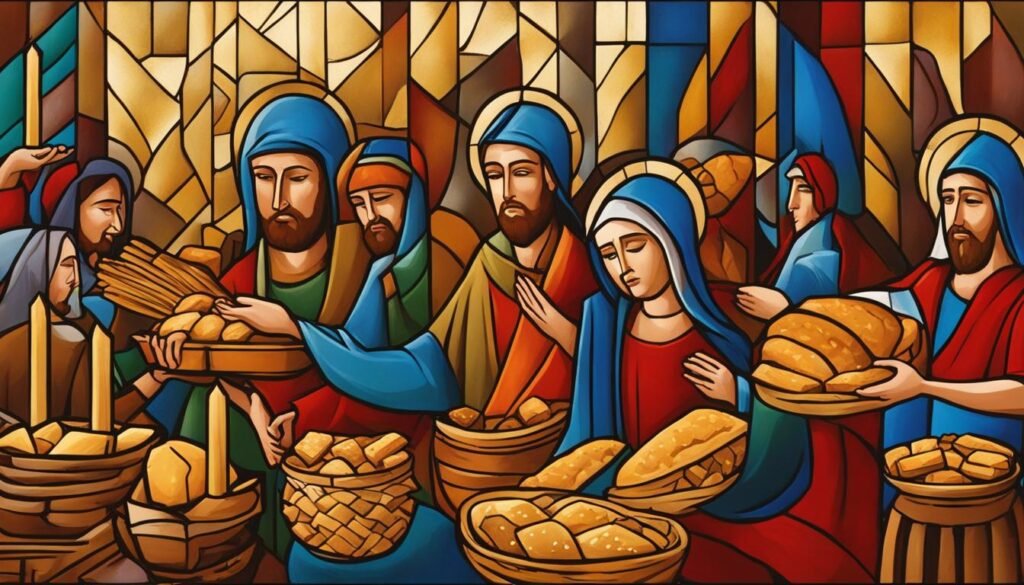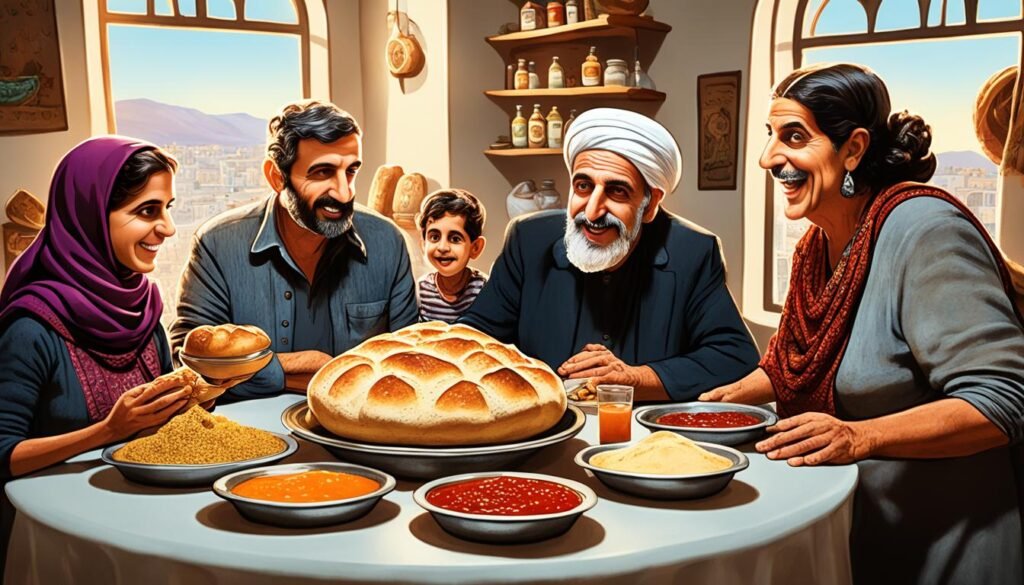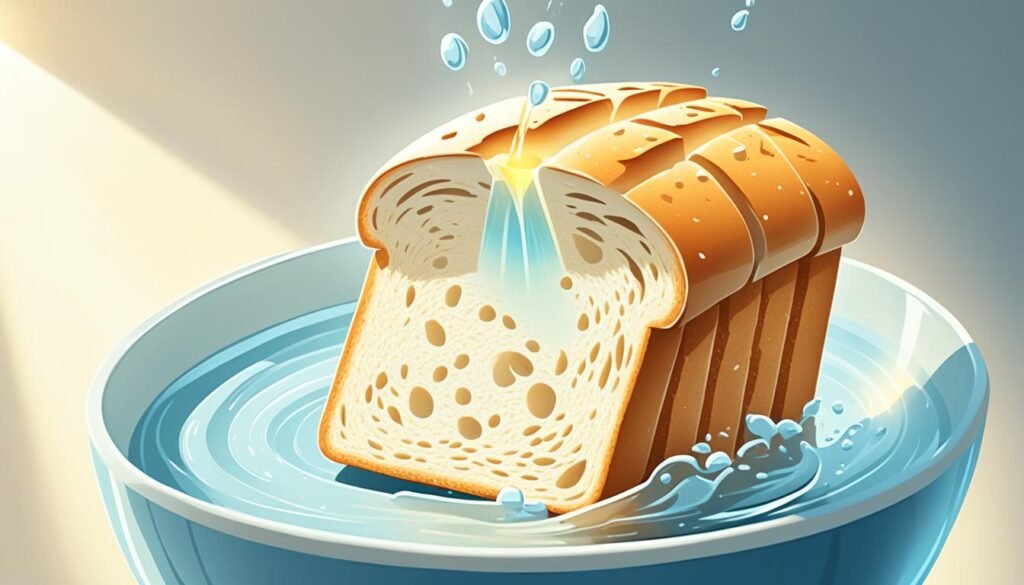The act of Jesus dipping the bread during the Last Supper holds immense significance in Christian tradition. This pivotal moment is documented in different accounts of the Bible, providing various perspectives and shedding light on the depth and symbolism of Jesus’ actions. Understanding the full picture requires combining these accounts and examining the traditions and context surrounding the Last Supper.
Key Takeaways:
- Jesus dipping the bread during the Last Supper is a significant event in Christian tradition.
- Multiple accounts in the Bible provide different perspectives on this moment, emphasizing the need to combine information for a comprehensive understanding.
- The Last Supper is linked to the Jewish Passover and contains symbolic acts.
- Interpretations connect Jesus’ action of dipping the bread to biblical events and Passover rituals.
- The combined record and affirmation of the Holy Spirit’s guidance in Scripture support the accuracy and divine authority of Jesus’ actions during the Last Supper.
The Last Supper and the Jewish Passover
The Last Supper, where Jesus and his disciples gathered to celebrate, is deeply intertwined with the Jewish Passover. The Passover meal encompasses various symbolic acts that hold significant meaning. During this particular meal, Jesus makes a pronouncement about one of his disciples betraying him. It is within this poignant moment that Jesus engages in a symbolic act by dipping the bread and giving it to Judas, further emphasizing the profound significance of this gesture.
The Last Supper, being a Passover meal, incorporates elements of Jewish tradition and ritual. These symbolic acts serve to convey important messages and spiritual truths to those partaking in the meal. The act of Jesus dipping the bread and giving it to Judas serves as a powerful symbol, conveying the weightiness of the impending betrayal and ultimate sacrifice that Jesus would face.
Different Interpretations of the Act
Scholars have proposed different interpretations of Jesus dipping the bread and giving it to Judas during the Last Supper. One fascinating possibility is that Jesus was recalling the betrayal of Joseph in the Old Testament, connecting this event to the symbolic acts of the Jewish Passover. This interpretation adds depth and significance to Jesus’ actions, shedding light on the profound meaning behind this pivotal moment.
“The act of dipping the bread may be connected to the dipping of Joseph’s coat in goat’s blood by his brothers, symbolizing the initiation of his descent into Egypt,” propose scholars.
This association draws from the story in the Old Testament, where Joseph’s jealous brothers dipped his coat of many colors in goat’s blood to deceive their father into thinking Joseph had been killed. This act marked the beginning of Joseph’s descent into slavery and eventual rise to power in Egypt.
“The connection between the dipping of Joseph’s coat and Jesus dipping the bread suggests a parallel between the betrayal of Joseph and the impending betrayal of Jesus,” explains one interpretation.
By alluding to the betrayal of Joseph, Jesus may have been highlighting the theme of betrayal that would ultimately lead to his crucifixion. This interpretation deepens our understanding of the symbolism and significance of Jesus’ actions during the Last Supper.

Rituals of the Passover Seder
In the Passover Seder, participants engage in various rituals, including the washing of hands and the karpas ritual.
During the karpas ritual, a green vegetable is dipped twice into wine vinegar (or saltwater), potentially symbolizing the betrayal of Joseph by his brothers or the dipping of hyssop into lamb’s blood. This tradition adds another layer of symbolism to Jesus’ act of dipping the bread during the Last Supper.
Symbolism plays a significant role in the Passover Seder, as each ritual and action carries deep meaning and significance. The act of dipping the karpas vegetable reminds participants of the journey from slavery to freedom, reaffirming their connection to the Exodus story in the Old Testament.
“The karpas dipping serves as a powerful reminder of the bitter tears shed in Egypt and the deliverance from bondage,” explains Rabbi Leah Sarna, who serves the community at Anshe Emet Synagogue in Chicago.
“By connecting Jesus’ act of dipping the bread during the Last Supper to the Passover Seder rituals, we can appreciate the layers of symbolism that were present in this significant event.”
This connection between the Passover Seder and Jesus’ actions highlights the rich tapestry of biblical traditions and their profound influence on the life and teachings of Jesus. As participants in the Passover Seder engage in these rituals, they are reminded of their connections to their ancestors, the story of the Exodus, and the redemption that Jesus would bring through his sacrifice.
| Passover Seder Rituals | Symbolism |
|---|---|
| Washing of hands | Purification and preparation for the meal |
| Karpas Ritual | Symbolic act reminding of the journey from slavery to freedom |
| Matzah | Unleavened bread representing haste and humility |
| Maror | Bitter herbs symbolizing the bitterness of slavery |
| Charoset | Symbolic reminder of the mortar used by the Israelites in their bondage |
| Cup of Redemption | Joyful celebration of freedom and salvation |
Customs in Yemenite Communities
In many Yemenite communities, a unique tradition is observed during the Passover Seder. This tradition involves the dipping of the karpas vegetable into charoset, a delectable mixture made from wine, nuts, and occasionally, dates.
This longstanding custom holds deep historical and symbolic significance, calling to mind the narrative of Joseph’s coat of many colors and the betrayal he endured. In the biblical account, Joseph’s brothers infamously dipped his vibrant coat into goat’s blood to deceive their father, Jacob, into thinking that Joseph had been fatally attacked by a wild animal.
It is this poignant imagery of dipping that resonates powerfully with the act of Jesus dipping the bread and giving it to Judas during the Last Supper. This connection highlights the intricate tapestry woven between the Last Supper and the rich traditions and symbolism of the Passover Seder.
The Symbolic Link
The Yemenite custom of dipping the karpas vegetable into charoset reinforces the biblical theme of betrayal and blood symbolism related to Joseph’s story. The act symbolizes the betrayal and injustice suffered by Joseph, foreshadowing the subsequent betrayal Jesus would face by Judas.
The act of Jesus dipping the bread and giving it to Judas resonates with the Yemenite custom of dipping the karpas vegetable into charoset, further connecting the Last Supper to the traditions and symbolism of the Passover Seder.
| Custom | Symbolism |
|---|---|
| Karpas Vegetable | Represents the vibrant and colorful coat of Joseph |
| Charoset Mixture | Symbolizes the blood of the goat used to deceive Jacob regarding Joseph’s fate |
| Dipping | Evoke the betrayal and injustice experienced by Joseph and foreshadows Jesus’ impending betrayal |
The intertwining of these customs illuminates the divine connection between historical events and the religious observances associated with both the Passover Seder and the Last Supper.

The image above represents the vibrant cultural tapestry of Yemenite communities, where the custom of dipping the karpas vegetable into charoset finds a cherished place in their Passover traditions.
The Biblical Record
When examining the account of Jesus dipping the bread and giving it to Judas during the Last Supper, it is important to consider the various translations of the Bible. Translations such as ESV, NIV, NASB, CSB, NLT, and KJV provide slightly different wording but all capture the essence of Jesus’ actions.
These translations emphasize that Jesus would dip a morsel of bread and give it to Judas, highlighting the specific details of this significant moment. The choice of the word “morsel” conveys the delicacy and intimacy of the act, emphasizing the intention behind Jesus’ actions.
By examining the different translations, readers can gain a deeper understanding of the events of the Last Supper. Through these variations, the message of Jesus’ betrayal and sacrifice is further emphasized, underscoring the profound significance of this event in the Bible.
| Bible Translation | Phrase Used |
|---|---|
| ESV | He dipped the morsel and gave it to Judas |
| NIV | Dipping the piece of bread, he gave it to Judas |
| NASB | He dipped the morsel and gave it to Judas |
| CSB | Dipping the piece of bread, he gave it to Judas |
| NLT | He dipped it in the dish, then he gave it to Judas |
| KJV | He dipped the sop and gave it to Judas |
The Importance of the Combined Record
The different accounts of Jesus dipping the bread and giving it to Judas in the Bible do not contradict each other but rather provide complementary information. Combining all the records helps clarify the details of this event and highlights the accuracy of the Bible. It is through considering all the perspectives that we can understand the significance and meaning behind Jesus’ actions during the Last Supper.
The Role of the Holy Spirit
The Bible’s inerrancy is affirmed by the belief that the Holy Spirit guided the writing of Scripture. The accounts of Jesus dipping the bread and giving it to Judas are without error because they were inspired by the Holy Spirit. This understanding emphasizes the divine nature of the Bible and reinforces the importance of these events in the narrative of Jesus’ life.
The Reminder of an Important Truth
The act of Jesus dipping the bread and giving it to Judas at the Last Supper serves as a reminder of an important truth. This truth is that the Bible is without error and inerrant in all that is written, as it was inspired by the Holy Spirit. Jesus’ actions during this pivotal moment in history affirm the divine authority and reliability of Scripture.
By dipping the bread and giving it to Judas, Jesus symbolically demonstrated the significance and ultimate truth of His sacrifice. This act not only highlights the significance of His impending betrayal and crucifixion, but also underscores the fidelity and accuracy of the written Word of God.
“I am the way, and the truth, and the life. No one comes to the Father except through me.” – John 14:6
The act of dipping the bread and giving it to Judas serves as a powerful reminder to believers of the truth and significance that Jesus embodies. His actions at the Last Supper demonstrate His role as the ultimate sacrificial lamb, providing salvation and eternal life through His death and resurrection.
In honoring this truth, Christians are called to embrace the Bible as the reliable and infallible source of divine revelation. Jesus’ actions during the Last Supper serve as a constant reminder of the significance of Scripture in shaping our beliefs, guiding our actions, and deepening our relationship with God.

| Reminder | Significance | |
|---|---|---|
| Event | The act of Jesus dipping the bread and giving it to Judas at the Last Supper | Symbolic demonstration of the importance of Jesus’ sacrifice |
| Truth | The Bible is without error and inerrant | The divine authority and reliability of Scripture |
| Impact | A reminder of the profound significance of Jesus’ actions | Emphasis on the truth and significance Jesus embodies |
| Call to Action | Embrace the Bible as the reliable and infallible source of divine revelation | Recognize the profound role of Scripture in shaping beliefs and guiding actions |
The Significance of Jesus’ Actions
Jesus’ act of dipping the bread and giving it to Judas during the Last Supper holds profound significance. It is a symbolic gesture that foreshadows the betrayal that would lead to Jesus’ crucifixion. This act not only highlights the depth of Jesus’ understanding of the events to come but also emphasizes the profound role of Judas in fulfilling God’s plan of salvation.
The image above depicts the Last Supper, a pivotal moment in Christianity where Jesus shared a final meal with his disciples. The act of Jesus dipping the bread and giving it to Judas during this meal represents the symbolic symbolism of betrayal. Just as Jesus knew of Judas’ intention to betray him, he willingly offered him the bread, acknowledging the role he would play in the unfolding of divine events.
“Truly, I say to you, one of you will betray me.” (Matthew 26:21)
This quote from the Gospel of Matthew captures the moment when Jesus announced the forthcoming betrayal. By dipping the bread and giving it to Judas, Jesus utilized a physical act to communicate a deeper message. This act not only served as a reminder of the significance of the Last Supper but also foreshadowed the imminent events that would lead to Jesus’ crucifixion.
Jesus’ actions during the Last Supper invite reflection on the complexities of human nature, the purpose of sacrifice, and the intertwining of divine plan and human agency. Through his act of dipping the bread and giving it to Judas, Jesus displayed both humility and foresight, emphasizing the profound theological themes embedded within the biblical narrative.
Conclusion
In conclusion, the act of Jesus dipping the bread and giving it to Judas during the Last Supper holds profound significance. This event is not only recorded in the Bible but also carries various interpretations and symbolic meanings. By combining the different accounts from the Bible and considering the traditions of the Passover Seder, we gain a deeper understanding of the rich depth and significance of this moment in history.
Jesus’ actions during the Last Supper serve as a reminder of the divine authority of Scripture and the fulfillment of God’s plan. This act of dipping the bread not only foreshadows the betrayal that leads to Jesus’ crucifixion but also highlights His remarkable knowledge of the events to come. It is through His sacrifice that God’s plan of salvation is fulfilled, bringing hope and redemption to humanity.
As we reflect on the act of Jesus dipping the bread, we are reminded of the inerrancy and divine inspiration of Scripture, guided by the Holy Spirit. This event reaffirms the trustworthiness of the Bible as the authoritative source of truth. The combined record of Jesus’ actions during the Last Supper provides clarity and depth to our understanding of His mission and the intricate details surrounding this pivotal moment in history.
FAQ
What did Jesus dip the bread into?
Jesus dipped the bread during the Last Supper. Different accounts in the Bible provide varying perspectives on this event. Matthew states that the betrayer would dip his hand with Jesus in the bowl, while John states that Jesus would dip the morsel and give it to the one who would betray him. These accounts highlight the importance of combining all the information to understand the full picture.
How is the Last Supper connected to the Jewish Passover?
The Last Supper, where Jesus and his disciples gathered to celebrate, is linked to the Jewish Passover. The Passover meal involves various symbolic acts, and during this particular meal, Jesus proclaims that one of his disciples will betray him. It is during this moment that Jesus dips the bread and gives it to Judas, further emphasizing the significance of this act.
What are the different interpretations of Jesus dipping the bread?
Scholars have proposed different interpretations of Jesus dipping the bread and giving it to Judas. One possibility is that Jesus was recalling the betrayal of Joseph in the Old Testament, as the Jewish Passover contains symbolic acts that can be associated with this event. This interpretation adds depth to the significance of Jesus’ actions during the Last Supper.
What rituals are performed during the Passover Seder?
In the Passover Seder, participants engage in various rituals, including the washing of hands and the karpas ritual. During the karpas ritual, a green vegetable is dipped twice into wine vinegar (or saltwater), potentially symbolizing the betrayal of Joseph by his brothers or the dipping of hyssop into lamb’s blood. This tradition adds another layer of symbolism to Jesus’ act of dipping the bread during the Last Supper.
Are there any customs associated with dipping the karpas vegetable in Yemenite communities?
In many Yemenite communities, there is a custom of dipping the karpas vegetable into charoset, a mixture of wine, nuts, and sometimes dates. This custom is reminiscent of the blood symbolism associated with Joseph’s betrayal, where his brothers dipped his coat of many colors into goat’s blood. The act of Jesus dipping the bread and giving it to Judas resonates with this custom, further connecting the Last Supper to the traditions and symbolism of the Passover Seder.
What do different translations of the Bible say about Jesus dipping the bread?
Various translations of the Bible provide slightly different wording for the account of Jesus dipping the bread and giving it to Judas. Translations such as ESV, NIV, NASB, CSB, NLT, and KJV all capture the essence of Jesus’ actions during the Last Supper. These translations emphasize that Jesus would dip the morsel of bread and give it to Judas, highlighting the specific details of this significant moment.
How do the different accounts of Jesus dipping the bread complement each other?
The different accounts of Jesus dipping the bread and giving it to Judas in the Bible do not contradict each other but rather provide complementary information. Combining all the records helps clarify the details of this event and highlights the accuracy of the Bible. It is through considering all the perspectives that we can understand the significance and meaning behind Jesus’ actions during the Last Supper.
What role does the Holy Spirit play in ensuring the accuracy of the biblical record?
The Bible’s inerrancy is affirmed by the belief that the Holy Spirit guided the writing of Scripture. The accounts of Jesus dipping the bread and giving it to Judas are without error because they were inspired by the Holy Spirit. This understanding emphasizes the divine nature of the Bible and reinforces the importance of these events in the narrative of Jesus’ life.
What important truth does Jesus’ action of dipping the bread and giving it to Judas remind us of?
The act of Jesus dipping the bread and giving it to Judas at the Last Supper serves as a reminder of an important truth. This truth is that the Bible is without error and inerrant in all that is written, as it was inspired by the Holy Spirit. Jesus’ actions during this pivotal moment in history affirm the divine authority and reliability of Scripture.
What is the significance of Jesus’ actions of dipping the bread and giving it to Judas during the Last Supper?
Jesus’ act of dipping the bread and giving it to Judas during the Last Supper holds profound significance. It is a symbolic gesture that foreshadows the betrayal that would lead to Jesus’ crucifixion. This act not only highlights the depth of Jesus’ understanding of the events to come but also emphasizes the profound role of Judas in fulfilling God’s plan of salvation.
Source Links
- https://www.bibleref.com/John/13/John-13-26.html
- https://www.neverthirsty.org/bible-qa/qa-archives/question/did-jesus-dip-the-morsel-and-give-it-to-judas/
- https://aleteia.org/2022/04/13/why-did-jesus-dip-a-piece-of-food-and-give-it-to-judas/

I’m Benjamin, a passionate spiritual seeker and creator of Verses and Prayers. Alongside my girlfriend Emma and our pet lizard Mulle, I cherish family life, enjoy exploring new places, and am deeply involved in my church community. My love for reading and singing biblical verses inspires every aspect of my journey.

